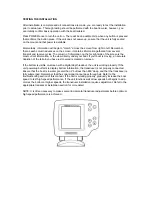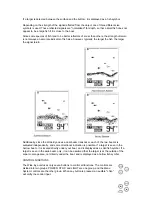
water, full of debris, the Wide Eye will select a lower sensitivity setting. In clear water, where there
is little debris to defract the sonar signal, the sensitivity is set higher.
The Sensitivity menu allows you to "bias" this automatic setting up or down based on personal
preference. You can select a bias of +5 to -5, for 11 different bias settings. A bias setting of "0"
has no effect on the automatic function. A +3 setting selects a sensitivity setting three steps
higher than the unit would normally select, so even the smallest returns are displayed onscreen.
A setting of -2 sets the sensitivity two steps below what the unit would normally select, so only the
largest targets or other returns are displayed.
Range
The Wide Eye adjusts the depth range automatically, so the
bottom return is displayed at the bottom 1/3 of the display. This
leaves the top 2/3 to display anything between the surface and
the bottom. As your boat moves over deeper or shallower
water, the unit adjusts the depth range of the display to keep
the bottom return in the same general area on the screen.
You may, however, choose to control this range adjustment
manually. By pressing ENTER, you can select manual
operation, meaning the unit will no longer adjust the depth
range automatically. The depth range selected is controlled by
the UP and DOWN arrow buttons. The depth ranges are 015',
30', 60', 120', 180', 240', 360', 480', & 600'.
If you alter the depth range, Manual operation is automatically selected and the area beneath the
bottom will no longer be blackened-in.
Summary of Contents for Wide Eye
Page 1: ......

























